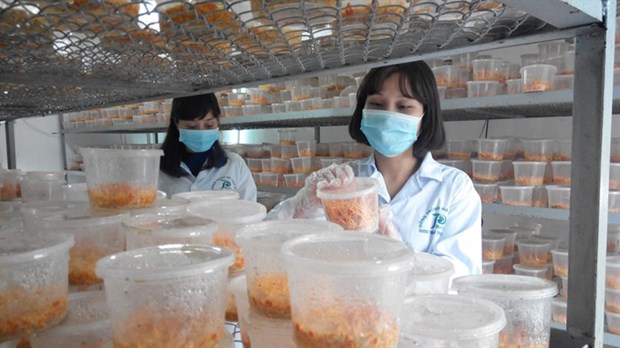Traditional medicine prices vary widely
 Workers check the development of dong trung ha thao(Cordyceps sinensis) at Thien Phuc Herbal Joint Stock Company in Hanoi’s Thanh Oai District. (Photo: VNA)
Workers check the development of dong trung ha thao(Cordyceps sinensis) at Thien Phuc Herbal Joint Stock Company in Hanoi’s Thanh Oai District. (Photo: VNA)Hanoi (VNS/VNA) - The use of herbal medicine is on the rise among Vietnamese in recent years, but concerns about management and arbitrary pricing are growing, too.
Shop owners claim there are many medicines that can cure all diseases, even fatal ones. The price of traditional medicines varies widely between companies and health facilities.
Statistics from the Traditional Medicine Management Department under the Ministry of Health showed that many medicinal substances share name but differ greatly in price.
Take "Bach cap" or Dix Stemonae Tuberosea, one of 237 herbs the department listed as an example.
The price of the root and body of "Bach cap" differed between companies. The price was declared at 3.9 million VND (172 USD) per kilo by Thang Long Pharmaceutical Oriental Medicine Joint Stock Company, nearly 5.1 million VND (225 USD) by Thien An Limited Company and 8.7 million VND (383 USD) by Vietnam Medicinal Materials Joint Stock Company.
"Dan sam" (or Radix Salviae Miltiorrhizae) varied similarly. The price of this medicine was listed at 206,000 VND (9 USD) by Dong Hung Duong Co.Ltd, more than triple the price of 64,000 VND (3 USD) by Khang Minh Pharmaceutical Company.
Such price differentials were recorded at hospitals as well.
Tran Van On, head of the Department of Botany under the Hanoi University of Pharmacy, said the bid winning price for each kind of traditional medicine might differ between hospitals by a factor of six or 10.
"This indicates that management in terms of quality and price of materials for traditional remedies in the public sector is not uniform," On said.
The price of "ba kich" (Indian Mulberry or Morinda officinalis) differered between localities. For instance, the price was 338,000 VND (15 USD) per kilo in Quang Nam province while in Thanh Hoa and Dien Bien province it was 630,000 VND (28 USD) and 730,000 VND (32 USD), respectively.
According to the Department of Management of Traditional Medicine (Ministry of Health), the management of imported pharmaceuticals faces many challenges.
Most households engaged in trading medicinal substances in Ninh Hiep commune in Hanoi’s Gia Lam district and in HCM City’s district 5 did not obtain sale invoices and their products are of unknown origin.
Some pharmaceutical companies and a number of drug manufacturers have bought materials from the above-mentioned households.
Meanwhile, these companies and manufacturers must show documents to prove the products’ origin while taking part in bidding to provide materials for hospitals. As a result, they must undertake measures to legalise their business.
Tran Hong Phuong, deputy director of the Traditional Medicine Management Department, attributed the difference in medicinal substance to the Ministry of Health’s regulation, which requires drugs imported into Vietnam have a certificate of origin and a certificate proving that each batch of medicinal substance has been certified. As a result, the certified medicine has a higher price than the one available on the market, according to Phuong.
Domestic demand for traditional pharmaceuticals is high in Vietnam.
Statistics from the health sector showed that the pharmaceutical industry consumes between 40,000-60,0000 tonnes of traditional or herbal medicinal materials per year. Around 80 percent were imported from foreign countries on small scale.
Pham Luong Son, Deputy General Director of Vietnam Social Security (VSS), said various shortcomings exist in examination and treatment for health insurance holders relating to traditional medicine.
According to him, the price of medicinal herbs set during the bidding process did not reflect their origin and quality.
Son noted Bach truat (or Atractylodes macrocephala Koidz) as an example.
The bid winning price for this kind of medicine was over 134,000 VND (6 USD) at the lowest level in Binh Duong province while it was 863,000 VND (38 USD) at the highest level in Ha Giang province, he said.
The representative of VSS also blamed loose management on facilities engaged in manufacture and trade of traditional medicine for the high price of medicinal herbs.
Some medicinal herbs could be cultivated in Vietnam, but they are often purchased by Chinese traders at a very cheap price and then reimported into the country, causing price hikes.
Nguyen Ta Tinh, head of Pharmacy and Health Facilities Department under the VSS, said the price of many medicinal herbs rose by 60 per cent from 2014 to 2016.
He blamed the bidding councils for this. The bidding councils should set a single price so as to narrow the price differential between localities, thus achieving a reasonable winning price.
In the coming months, the VSS would coordinate with the Traditional Medicine Management Department to inspect a number of provinces to review the price, Tinh said.-VNA












